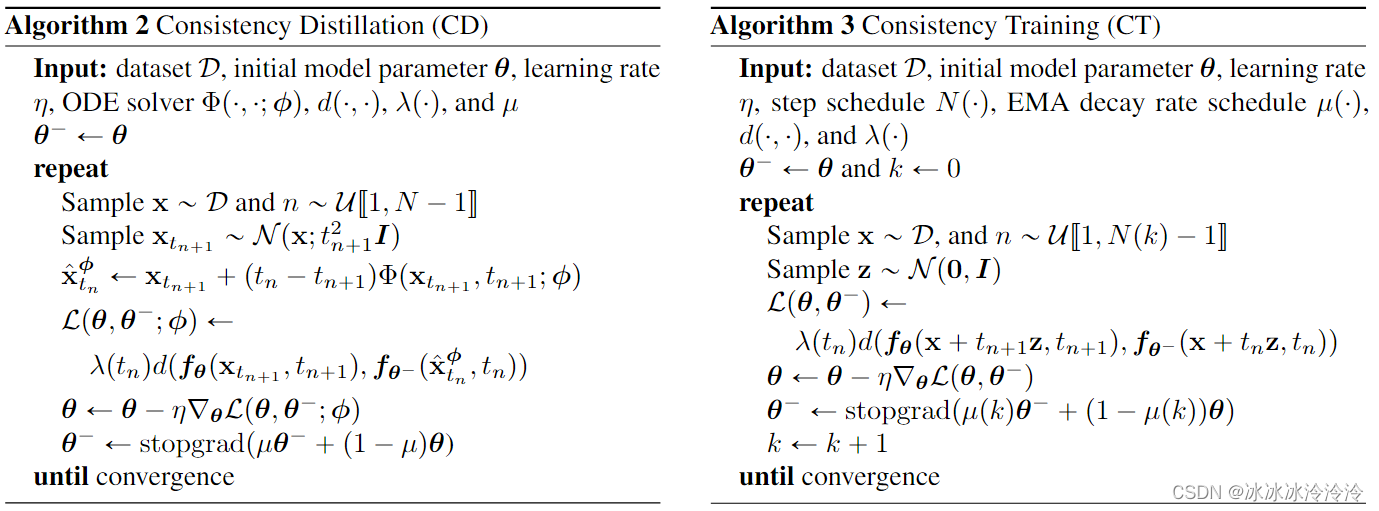简介
Diffusion models需要多步迭代采样才能生成一张图片,这导致生成速度很慢。一致性模型(Consistency models)的提出是为了加速生成过程。
Consistency models可以直接一步采样就生成图片,但是也允许进行多步采样来提高生成的质量。
Consistency models可以从预训练的扩散模型蒸馏得到,也可以作为独立的生成模型从头训练得到。
PF ODE
论文中考虑的PF ODE(Probability Flow Ordinary Differential Equation)形式如下:
d
x
t
d
t
=
−
t
s
ϕ
(
x
t
,
t
)
\frac{d \mathbf x_t}{d t} = -ts_\phi(\mathbf x_t, t)
dtdxt=−tsϕ(xt,t)其中
s
ϕ
(
x
t
,
t
)
≈
∇
log
p
t
(
x
)
s_\phi(\mathbf x_t, t) \approx \nabla\log p_t(\mathbf x)
sϕ(xt,t)≈∇logpt(x)是分数函数,
t
∈
[
0
,
T
]
t \in [0, T]
t∈[0,T]。
从初始分布
x
^
T
∼
N
(
0
,
T
2
I
)
\mathbf{\hat x_T} \sim \mathcal N(\mathbf 0, T^2 \mathbf I)
x^T∼N(0,T2I)中采样,然后逆向求解ODE,得到的
x
^
0
\mathbf{\hat x_0}
x^0是近似服从数据分布的样本。值得注意的是,为了保证数值稳定,在本文中用
x
^
ϵ
\mathbf{\hat x_\epsilon}
x^ϵ当做最后的近似样本,
ϵ
\epsilon
ϵ是一个接近0的小正数。
一致性模型(Consistency models)
给定一个PF ODE(Probability Flow Ordinary Differential Equation) { x t } t ∈ [ ϵ , T ] \{\mathbf x_t\}_{t\in[\epsilon, T]} {xt}t∈[ϵ,T],一致性函数(consistency function)被定义为 f : ( x t , t ) → x ϵ f:(\mathbf x_t, t) \rightarrow \mathbf x_\epsilon f:(xt,t)→xϵ,其中 ϵ \epsilon ϵ是一个接近0的小正数,是ODE求解器停止的位置。一致性函数具有self-consistency性质,即对于PF ODE轨迹上的任意点输出都是一样的。一致性模型 f θ f_\theta fθ的是从数据中估计的一致性函数。
给一个训练好的一致性模型
f
θ
(
⋅
,
⋅
)
f_\theta(\cdot, \cdot)
fθ(⋅,⋅),可以通过一致性模型一步生成了结果:首先从初始分布中采样
x
^
T
∼
N
(
0
,
T
2
I
)
\mathbf{\hat x_T} \sim \mathcal N(\mathbf 0, T^2 \mathbf I)
x^T∼N(0,T2I),然后用一致性模型计算
x
^
ϵ
=
f
θ
(
x
^
T
,
T
)
\mathbf{\hat x_\epsilon} = f_\theta(\mathbf{\hat x_T}, T)
x^ϵ=fθ(x^T,T)。也可以调用一致性模型多次生成更准确的结果,如Algorithm 1所示,迭代的去噪和添加噪声。

Consistency models的训练算法有两种,一种是从预训练的扩散模型蒸馏(Algorithm 2),一种是作为独立的生成模型从头训练(Algorithm 3)。

感觉一致性模型和EDM1有共同之处,在每一步中都想恢复出
x
0
\mathbf x_0
x0,但是一致性模型训练时优化的目标是self-consistency性质,通过self-consistency性质来在保证每一步中都能直接恢复出
x
0
\mathbf x_0
x0。
《Elucidating the design space of diffusion-based generative models》 ↩︎





















 1979
1979











 被折叠的 条评论
为什么被折叠?
被折叠的 条评论
为什么被折叠?








